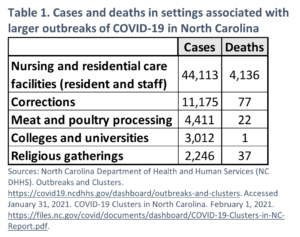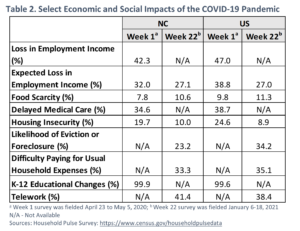

By Brieanne Lyda-McDonald
As COVID-19 case rates in the Carolinas rose through the summer and began spiking in fall 2020, the North Carolina Institute of Medicine and the South Carolina Institute of Medicine & Public Health have monitored state-level impacts of the pandemic and state and federal actions to address the fallout from the crisis. A new joint issue brief provides an update on these actions since our previous publications from April 8 and May 20, 2020. This blog post highlights the impacts of COVID-19 on social drivers of health in North Carolina. The full brief provides more detail on these issues, as well as state-level actions to address them.
Throughout the fall and into winter, rates of COVID-19 began to spike higher than any other time during the pandemic. In North Carolina, the percent of COVID-19 tests that were positive reached double-digits in December and peaked with a high of 17.0% on January 4, 2021.[1] Table 1 shows the number of cases and deaths that are associated with settings that have had larger outbreaks of COVID-19. Nursing and residential care facilities have experienced the largest outbreaks, resulting in 9,342 deaths in North Carolina as of February 1, 2021.[2]

Since businesses began closing in March 2020, the number of people filing for unemployment has reached over 1.4 million in North Carolina, accounting for nearly one in every three workers.[3], [4] 67% of people who applied for unemployment benefits were approved, with over $9.6 billion in payments as of January 29, 2021, including federal supplements, while 31% have been deemed ineligible for benefits.3 Counties across the state experienced a variation in peak unemployment rates— from 8.1% in Bertie County, NC to 24.5% in Dare County, NC. [5], [6]
As people have lost employment, many have also lost insurance coverage associated with those jobs. An analysis by Families USA estimated that as of May 2020 approximately 238,000 workers had lost health insurance, the fifth largest number in the nation.[7] Data is not available on the number of dependents who have lost coverage due to a family member’s unemployment, but estimates show that up to 20% of North Carolinian adults lacked health insurance last year, compared to 16% in 2018.[7]
The US Census Bureau has conducted the Household Pulse Survey since April 23, 2020, to provide weekly data on the impact of the pandemic on households across several indicators, including employment income, food scarcity, and housing insecurity. Table 2 shows several key points from this survey.

The availability of COVID-19 vaccines provides hope for an end to the pandemic, yet there is a long way to go to protect residents of North Carolina and address the social and economic toll of this unprecedented crisis. As state legislators convene in 2021, they will determine the best ways to help North Carolinians address these challenges. Congressional leaders are negotiating additional relief bills and the North Carolina Institute of Medicine and South Carolina Institute of Medicine and Public Health will monitor state-level funding allocations included in any legislation that is passed.
[1] North Carolina Department of Health and Human Services. NC DHHS COVID-19: Testing. https://covid19.ncdhhs.gov/dashboard/testing. Accessed January 31, 2021.
[2] North Carolina Department of Health and Human Services. COVID-19 Cases. https://covid19.ncdhhs.gov/dashboard/cases. Accessed February 1, 2021.
[3] North Carolina Department of Commerce. Division of Employment Security: Unemployment Benefits Data. https://des.nc.gov/need-help/unemployment-benefits-data. Accessed January 31, 2021.
[4] United States Bureau of Labor Statistics. North Carolina : Southeast Information Office : U.S. Bureau of Labor Statistics. https://www.bls.gov/regions/southeast/north_carolina.htm#eag. Accessed January 31, 2021.
[5] North Carolina Department of Commerce. Division of Employment Security: Unemployment Benefits Data. https://des.nc.gov/need-help/unemployment-benefits-data. Accessed January 31, 2021.
[6] North Carolina Department of Commerce. North Carolina’s April County and Area Employment Figures Released. https://files.nc.gov/nccommerce/press-release/files/Apr-2020-county-release-combined_0.pdf.
[7] United States Census Bureau. Household Pulse Survey. https://www.census.gov/data-tools/demo/hhp/#/?s_state=00037,00045. Accessed January 31, 2021.